Google's Tensor inside of Pixel 6, Pixel 6 Pro: A Look into Performance & Efficiency
by Andrei Frumusanu on November 2, 2021 8:00 AM EST- Posted in
- Mobile
- Smartphones
- SoCs
- Pixel 6
- Pixel 6 Pro
- Google Tensor
Google's IP: Tensor TPU/NPU
At the heart of the Google Tensor, we find the TPU which actually gives the chip is marketing name. Developed by Google with input and feedback by the team’s research teams, taking advantage of years of extensive experience in the field of machine learning, Google puts a lot of value into the experiences that the new TPU allows for Pixel 6 phones. There’s a lot to talk about here, but let’s first try to break down some numbers, to try to see where the performance of the Tensor ends up relative to the competition.
We start off with MLCommon’s MLPerf – the benchmark suite works closely with all industry vendors in designing something that is representative of actual workloads that run on devices. We also run variants of the benchmark which are able to take advantage of various vendors SDKs and acceleration frameworks. Google had sent us a variant of the MLPerf app to test the Pixel 6 phones with – it’s to be noted that the workloads on the Tensor run via NNAPI, while other phones are optimised to run through the respective chip vendor’s libraries, such as Qualcomm’s SNPE, Samsung’s EDEN, or MediaTek’s Neuron – unfortunately only the Apple variant is lacking CoreML acceleration, thus we should expect lower scores on the A15.

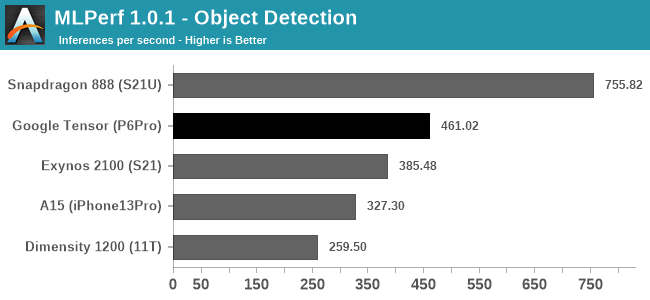
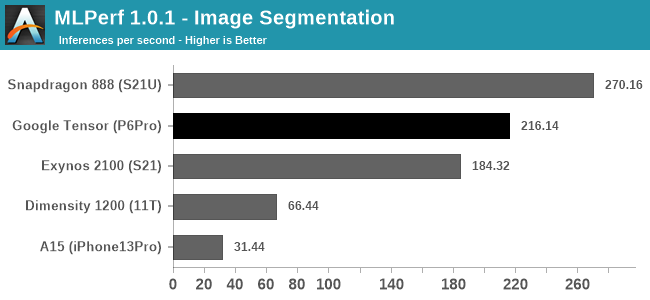
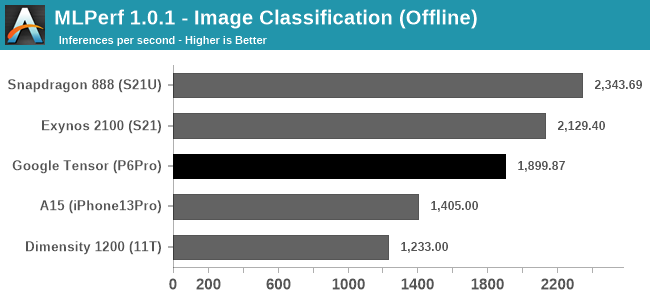
Starting off with the Image Classification, Object Detection, and Image Segmentation workloads, the Pixel 6 Pro and the Google Tensor showcase good performance, and the phone is able to outperform the Exynos 2100’s NPU and software stack. More recently, Qualcomm had optimised its software implementation for MLPerf 1.1, able to achieve higher scores than a few months ago, and this allows the Snapdragon 888 to achieve significantly better scores than what we’re seeing on the Google Tensor and the TPU – at least for those workloads, in the current software releases and optimisations.
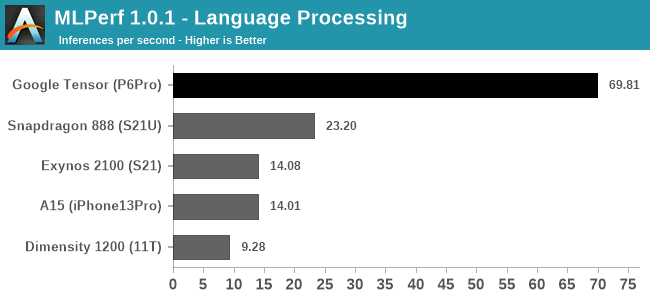
The Language Processing test of MLPerf is a MobileBERT model, and here for either architectural reasons of the TPU, or just a vastly superior software implementation, the Google Tensor is able to obliterate the competition in terms of inference speed.
In Google’s marketing, language processing, such as live transcribing, and live translations, are very major parts of the differentiating features that the new Google Tensor enables for the Pixel 6 series devices – in fact, when talking about the TPU performance, it’s exactly these workloads that the company highlights as being the killer use-cases and what the company calls state-of-the-art.
If the scores here are indeed a direct representation of Google’s design focus of the TPU, then that’s a massively impressive competitive advantage over other platforms, as it represents a giant leap in performance.
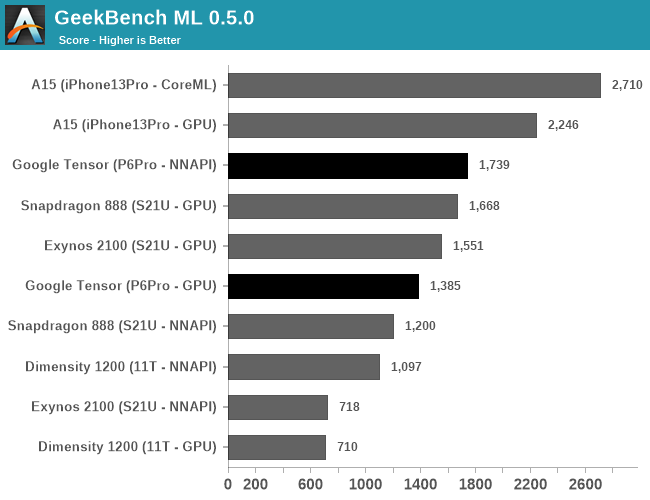
Other benchmarks we have available are for example GeekBench ML, which is currently still in a pre-release state in that the models and acceleration can still change in further updates.
The performance here depends on the APIs used, with the test either allowing TensorFlow delegates for the GPU or CPU, or using NNAPI on Android devices (and CoreML on iOS). The GPU results should only represent the GPU ML performance, which is surprisingly not that great on the Tensor, as it somehow lands below the Exynos 2100’s GPU.
In NNAPI mode, the Tensor is able to more clearly distinguish itself from the other SoCs, showcasing a 44% lead over the Snapdragon 888. It’s likely this represent the TPU performance lead, however it’s very hard to come to conclusions when it comes to such abstractions layer APIs.
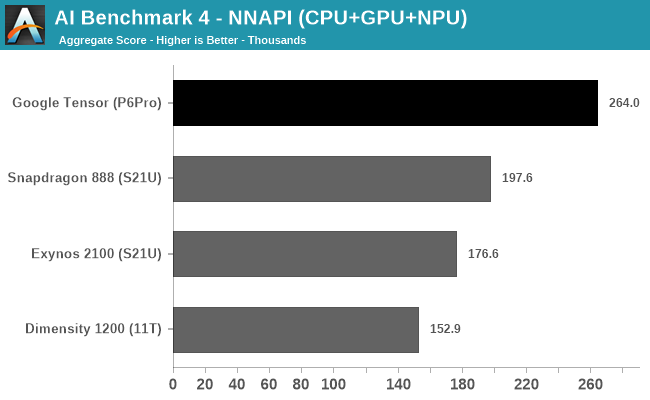
In AI Benchmark 4, when running the benchmark in pure NNAPI mode, the Google Tensor again showcases a very large performance advantage over the competition. Again, it’s hard to come to conclusions as to what’s driving the performance here as there’s use of CPU, GPU, and NPUs.
I briefly looked at the power profile of the Pixel 6 Pro when running the test, and it showcased similar power figures to the Exynos 2100, which extremely high burst power figures of up to 14W when doing individual inferences. Due to the much higher performance the Tensor showcases, it also means it’s that much more efficient. The Snapdragon 888 peaked around 12W in the same workloads, so the efficiency gap here isn’t as large, however it’s still in favour of Google’s chip.
All in all, Google’s ML performance of the Tensor has been its main marketing point, and Google doesn’t disappoint in that regard, as the chip and the TPU seemingly are able to showcase extremely large performance advantages over the competition. While power is still very high, completing an inference faster means that energy efficiency is also much better.
I asked Google what their plans are in regards to the software side of things for the TPU – whether they’ll be releasing a public SDK for developers to tap into the TPU, or whether things will remain more NNAPI centric like how they are today on the Pixels. The company wouldn’t commit yet to any plans as it’s still very early – in generally that’s the same tone we’ve heard from other companies as even Samsung, even 2 years after the release of their first-gen NPU, doesn’t publicly make available their Eden SDK. Google notes that there is massive performance potential for the TPU and that the Pixel 6 phones are able to use them in first-party software, which enables the many ML features for the camera, and many translation features on the phone.










108 Comments
View All Comments
Wrs - Wednesday, November 3, 2021 - link
It’s Double data rateNaturalViolence - Wednesday, December 1, 2021 - link
So you're saying the data rate is actually 6400MHz? LPDDR5 doesn't support that. Only regular DDR5 does.Eifel234 - Wednesday, November 3, 2021 - link
I've had the pixel 6 pro for a week now and I have to say it's amazing. I don't care what the synthetic benchmarks say about the chip. It's crazy responsive and I get through a day easily with heavy usage on the battery. At a certain point extra CPU/gpu power doesn't get you anywhere unless your an extreme phone gamer or trying to edit/render videos both of which you should really just do on a computer anyway. What I care mostly about is how fast my apps are opening and how fast the UI is. Theres a video comparison on YouTube of the same apps opening on the iPhone 13 max and the p6 pro and you know what the p6 pro wins handily at loading up many commonly used apps and even some games. Regarding the battery life, I expect to charge my phone nightly so I really don't care if another phone can get me a few more hours of usage after an entire day. I can get 6 hours of SOT and 18 hours unplugged on the battery. More than enough.Lavkesh - Thursday, November 11, 2021 - link
Well that would be true if iOS apps were the same as Android apps. In the review of A15, it was called out how Android AAA games such as Genshin Impact were missing visual effects altogether which were basically present in iOS. These app opening tests are pretty obtuse in my opinion and it checks out as well. For a more meaningful comparison, have a look at this and how badly this so called google soc is spanked by A15!Here's Exynos 2100 vs Google Pixel 6
https://www.youtube.com/watch?v=iDjzPPtC4kU&t=...
Here's Exynos 2100 vs iPhone
https://www.youtube.com/watch?v=U9A91bnVBU4
Arbie - Friday, November 5, 2021 - link
No earphone jack, no sale.JoeDuarte - Saturday, November 6, 2021 - link
This piece has been up for three days, and there are still tons of typos and errors on every page? How is this happening? Why doesn't AnandTech maintain normal standards for publishers? I can't imagine publishing this piece without reading it. And after publishing it, I'd read it again – there's no way I wouldn't catch the typos and errors here. Word would catch many of them, so this is just annoying."...however it’s only 21% faster than the Exynos 2100, not exactly what we’d expect from 21% more cores."
The error above is substantive, and undercuts the meaning of the sentence. Readers will immediately know something is wrong, and will have to go back to find the correct figure, assuming anything at AnandTech is correct.
"...would would hope this to be the case."
That's great. How do they not notice an error like that? It's practically flashing at you. This is just so unprofessional and junky. And there are a lot more of these. It was too annoying to keep reading, so I quit.
ChrisGX - Monday, November 8, 2021 - link
Has Vulkan performance improved with Android 12? That is a serious question. There has been some strange reporting and punditry about the place that seems intent on strongly promoting the idea that the Tensor Mali GPU is endowed with oodles and oodles of usable GPU compute performance.In order to make their case these pundits offer construals of reported benchmark scores of Tensor that appear to muddle fact and fiction. A recent update of Geekbench (5.4.3), for instance, in the view of these pundits, corrects a problem with Geekbench that caused it to understate Vulkan scores on Tensor. So far as I can tell, Primate Labs hasn't made any admission about such a basic flaw in their benchmark software, that needed to be (and has been) corrected, however. The changes in Geekbench 5.4.3, on the contrary, seem to be to improve stability.
I am hoping that there is a more sober explanation for the recent jump in Vulkan scores (assuming they aren't fakes) than these odd accounts that seem intent on defending Tensor from all criticism including criticism supported by careful benchmarking.
Of course, if Vulkan performance has indeed improved on ARM SoCs, then that improvement will also show up in benchmarks other than Geekbench. So, this is something that benchmarks can confirm or disprove.
ChrisGX - Monday, November 8, 2021 - link
The odd accounts that I believe have muddled fact and fiction are linked here:https://chromeunboxed.com/update-geekbench-pixel-6...
https://mobile.twitter.com/SomeGadgetGuy/status/14...